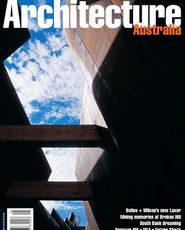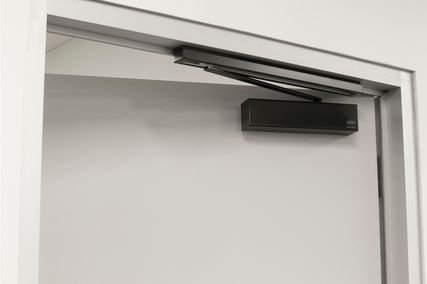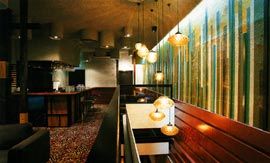
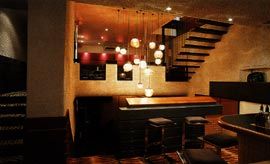
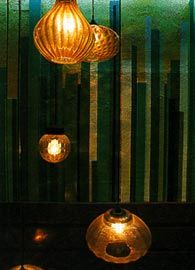
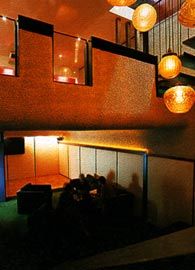
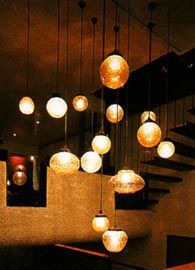
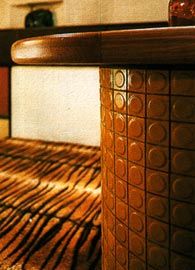

Phoenix Bar in Flinders Street, Melbourne, by Six Degrees, is a renovation of the three-storey Phoenix Hotel. The hotel was built in the 1860s, and its brick facade dates from the 1920s; but its dominant style comes from a 1960s refurbishment that altered the floor levels by inserting an in situ concrete mezzanine. Rather than continue the cycle of demolition and renewal, Six Degrees have treated the run-down pub as a found object, waiting to be given a new context and a new reading.
Features from the 1960s – ceilings and walls sprayed with Vermiculite, which curve smoothly at their junctions, and a continuous dado of horizontal hardwood boards – are juxtaposed with luxurious tiger and zebra print carpet, patterned fabric wall panelling, and hardwood posts with random yellow stripes painted at hip, shoulder or elbow level.
The major structural change is the addition of a stair connecting the mezzanine to the upper level. Appearing to hang delicately from steel rods (a reference to the stairs of Falling Water, Frank Lloyd Wright’s famous 1939 Kaufmann residence), the treads are actually cantilevered from a steel beam concealed in the wall behind newly sprayed Vermiculite. Added to this are elements from the 1960s that were not part of the previous fit-out but could have been – a conversation pit on the ground floor, a chandelier of textured glass light fittings familiar from sixties suburban houses, and so on. The result of this hybrid attitude to renovation is that the distinction between old and new is obscured, and history is tampered with. In this uncertain context everything is potentially new. Rather than primarily generating architectural form, Six Degrees are manipulating perception.
Take the screen. In the context of a wall dividing two spaces, the industrial remnant reads as decorative screen. On a stack of scrappy off-cuts in a factory tip it reads as scrappy off-cut, and requires a particular eye to imagine its new life.
Some might argue that the tedious found-object gag is no longer funny. But this is the least interesting aspect of the screen. In fact it performs a social role, a comfort role, dividing yet allowing for survey. The Phoenix has spaces for being observed as much as spaces for privacy – inclusive and low key, with a different feel at different times for different people.
This is an architecture that treats the human animal kindly.
If the building had been gutted, painted white with curvy groovy new form making, we would analyse the design on its own terms – is this a good bar, a good style, do we like it? Instead we are left to analyse past styles in the context of current fashion – do we now like the sixties? Is it old? What does old mean?%br% An 1832 pub called the Fail Me Never; 1920s facade; 1960s interior; 2001 interior update with 1970s lights, sunken lounge and Frank Lloyd Wright stair. A cost-plus contract, a “suck it and see approach”, materials pulled off the wall, re-dressed and re-fitted, carpet that came late in the piece, the chance to make an artwork. There’s a low glossy ceiling inspired by Jean Nouvel’s Arab Institute. There’s an Escher feel to the stairs and levels.
How did the design evolve? There are no traditional working drawings, rather a set of A4 sheets with mostly hand drawn perspectives and very personal, familiar annotations.
The nature of architecture, despite public perceptions to the contrary, has always been many hands, many authors.
Is this blending of old and new under the supervision of Six Degrees, this dense layering, the work of many architects?
This project, unfolding towards us out of the future, shows us what we have already seen. The objects and materials are not new, but the attitude to architecture is.
Toby Horrocks is a Melbourne-based architectural graduate and writer.
Phoenix Hotel
Architect Six Degrees—project architect Mark Healy. Engineer Robin Bliem. Builder Grant McKenzie.

